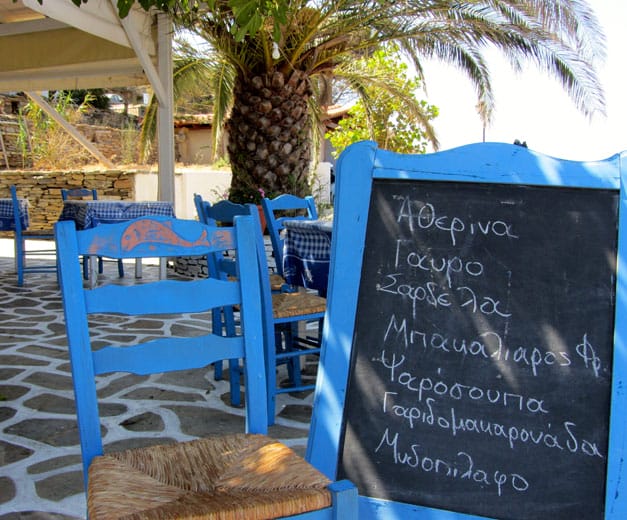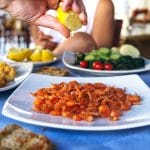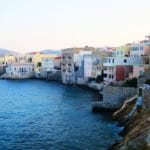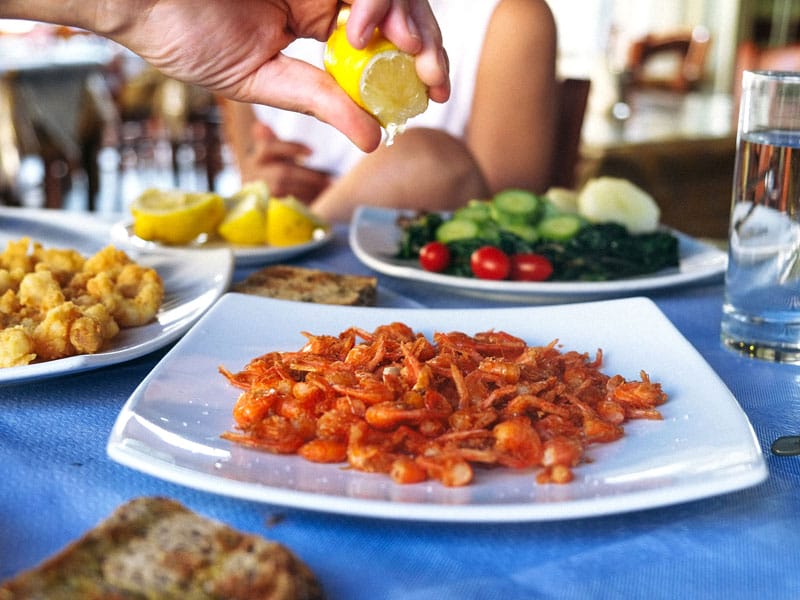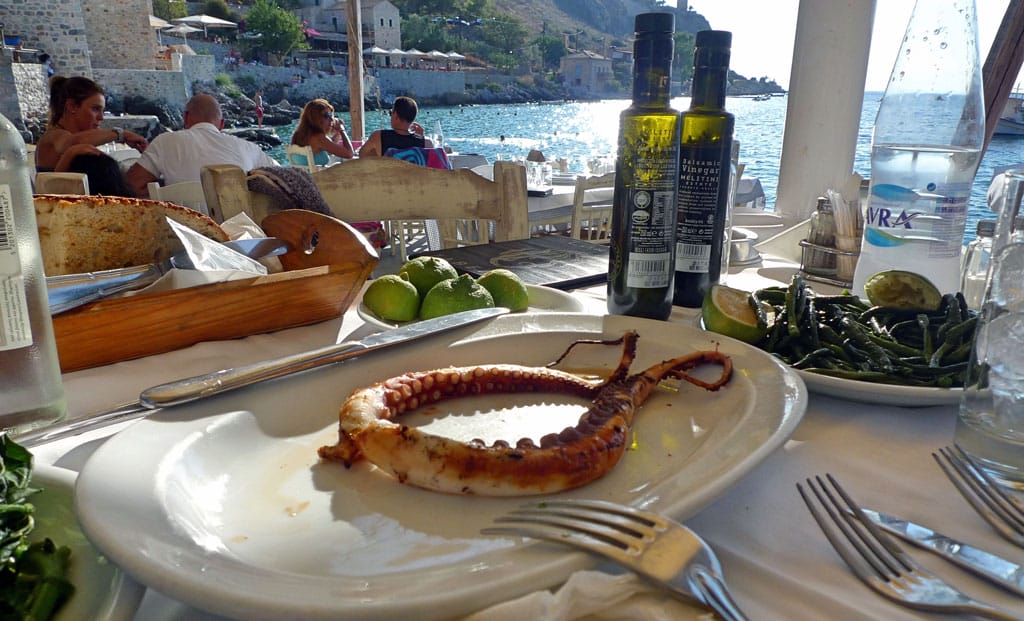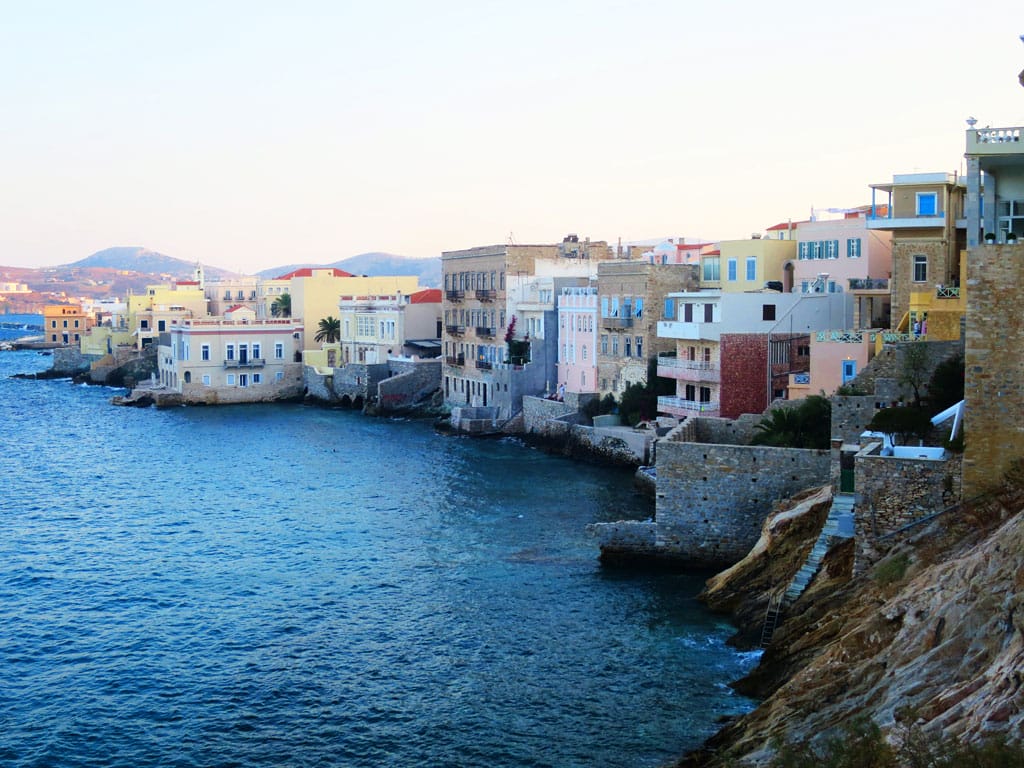Some islands, Mykonos and Santorini for example, are known for their temples of gastronomy. Others, like Tinos, Milos, Syros and Sifnos, possess solid reputations for uniformly excellent tavernas. Until recently, Andros, a green anomaly in the treeless, windswept Cycladic chain, had two main attractions for tourists: a world-class modern art museum and a network of well-maintained hiking trails. You could get a decent meal after you’d seen the exhibition in Hora or trekked up to a 1,000-year-old monastery or down a river lined with water mills, but it wouldn’t be something to write home or tweet about.
This is no longer the case. In recent years, this island of shipowners and sea captains is acquiring a new profile where good food is the norm rather than the exception. Surprisingly, some of the best eateries have been around for decades and are going even stronger, while three others with a far shorter history are well on their way to becoming institutions.
It may seem strange that Andros, the birthplace of such famous shipping dynasties as Goulandris and Embirikos as well as dozens of less renowned but very wealthy families, should have such a low-key food scene. But it’s just possible that they get all the luxuries they want in London, New York and Geneva and prefer old-fashioned, traditional meals when they come home for the holidays. So don’t look for blinis and caviar. Instead, seek out the specialty shops with local delicacies like a wide range of honeys, lemon blossom jam, cheeses soft and hard, preserved capers and caper leaves, and amygdalota (crushed almond) and kaltsounia (crushed walnut) confections covered with powdered sugar and rosewater.
You’ll find such goodies in two shops almost across from each other on the main gray-marble-paved street in Hora: Rodozachari and the tiny Paradosiako Pantopoleio (“Traditional Grocers”), whose decorative baskets hang above the entrance. Our favorite, though, is Yannis Batis’s funky Andriotiko Pantopoleio at the south end of the island’s port, Gavrio. There you can not only shop, you can sit with an ouzo, boutique beer or a Cycladic wine and sample some of the artisanal cheeses and charcuterie that Batis brings from neighboring islands like Naxos, Tinos, Serifos, Syros and even Ios or Samothrace.
From there it’s only a few steps to Yorgos Sigalas’s mulberry-shaded mezedopoleio, Karavostasi, the last establishment on this end of the port. Open four years now, Karavostasi is the most recent addition to our list of the best places to eat on Andros. We love it for Sigalas’s handsome, smiling presence but also for his repertoire of seafood dishes: keftedes or fritters from almost any substance you can imagine – from zukes to tomato, cheese, octopus, mussels, potato and even meat – copious salads and the opulent fisherman’s spaghetti. Sigalas caught the restaurant bug while working as a waiter in the evenings, assimilating the best tricks of the trade while inheriting kitchen skills from his father, who was a ship’s cook.
We prefer this quieter south end of the port to the main waterfront strip, where most of Gavrio’s cafés, shops and eateries are concentrated.
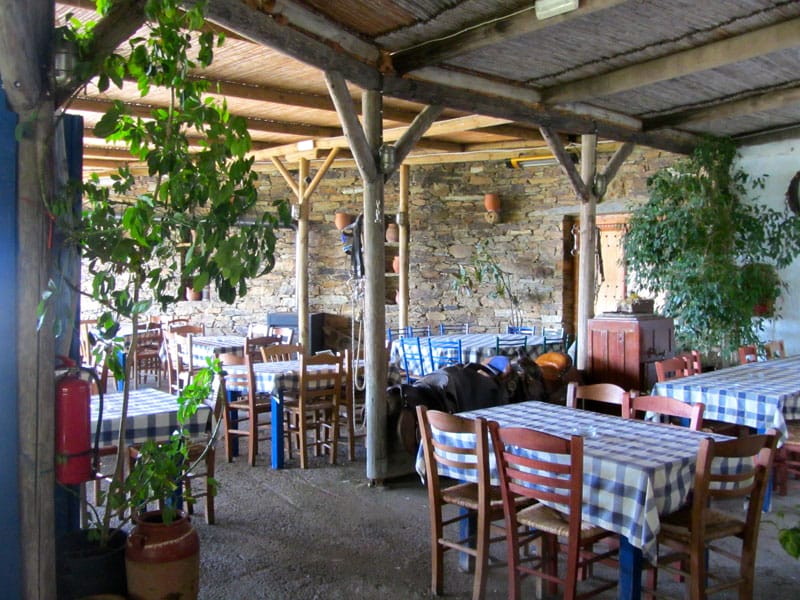
Heading out of Gavrio to the west will take you down to Fellos Beach or up to Ano Fellos and Kossis’s taverna, which in the 15 years since its inauguration has become the most popular meatery on the island. Like so many Andriots, Dimitris (Mitsos) Kossis had started out as a sailor but he quit to become a farmer. Three kids later, he decided to open a taverna to make ends meet. And unusually, he chose a gully just off the main road to the sparsely populated northwest as his location. Now, despite its relatively remote location, it attracts diners from as far away as Hora. Kossis has remained a farmer. He still raises cows and sheep, which supply milk for fresh homemade cheese and delectable lamb chops, and he grows many of the taverna’s vegetables. He even has a few horses for children to ride up and down the courtyard while their parents savor a prolonged meal.
Kossis’s greatest assets have been his flexibility, charm and wonderful family. When some of his British regulars told him about aging meat, he listened and adapted his menu to include superlative tender steaks cooked to order, even rare – a difficult concept for most Greeks. When others suggested that a red Nemea might be nicer than a Chateau Cardboard or the local, amber-colored plonk, he obliged. The interiors are attractively rustic, free carafes of tsipouro arrive with the place settings, and the service is always carried out with a smile by Kossis’s engaging sons, Yannis and Panagiotis. Apart from the chops and steaks, we recommend the liver and barbecued chicken, but if you’re not into meat, the sides of salads, fried zucchini and eggplant, saganaki (fried cheese), thick tzatziki, oil-drizzled grilled bread and crisp fried potatoes will more than satisfy you.
 Heading east out of Gavrio will take you along the coast to a series of pleasant beaches. Here at Agios Petros, maybe 10 minutes from the port, is Yiannoulis, whose garrulous owner started it as a café in the late ’50s. Yiannoulis (little Yannis) had been a seafarer, too, until a shipwreck convinced him to keep his feet on dry land, or so his wife, Katina, told us. Sitting in the kitchen wrapping chard leaves into dolmades as she’s done since their marriage in ’62, she told us how the café quickly expanded into the taverna, where Andriots have been congregating ever since.
Heading east out of Gavrio will take you along the coast to a series of pleasant beaches. Here at Agios Petros, maybe 10 minutes from the port, is Yiannoulis, whose garrulous owner started it as a café in the late ’50s. Yiannoulis (little Yannis) had been a seafarer, too, until a shipwreck convinced him to keep his feet on dry land, or so his wife, Katina, told us. Sitting in the kitchen wrapping chard leaves into dolmades as she’s done since their marriage in ’62, she told us how the café quickly expanded into the taverna, where Andriots have been congregating ever since.
Whether you’ve been swimming or are driving to Gavrio to catch the ferry, Yiannoulis is an oasis of shade, good service and specialties such as froutalia, the island’s famous omelet with sausage, preserved pork and fried potatoes, zucchini flower croquettes (kolokythopoula), baked eggplant, keftedes, those and other types of dolmades, beautifully cooked fresh fish when available and artichokes and broad beans from their garden in spring. Poppi, Katina and Yiannoulis’s daughter, runs the kitchen now; her husband and her brother, both named Niko, are efficient, cordial waiters. Ask for doppio or local cheese instead of feta to go with your village salad.
After Gavrio, the next village is Batsi, a former fishing hamlet that collects most of the island’s tourists. You can get a good idea of what it used to look like by examining the black-and-white photos on the walls in Stamatis’s taverna, up the steps opposite the little marina at the south end of town. Stamatis, another institution, opened in 1965, and the décor has not changed since we discovered it in the ’80s. Then, its only drawback was the absence of a view, but recently Stamatis’s son, Yannis, and his Greek-American wife, Callie, acquired a balcony-like room opposite which overlooks the port and makes summer dining more romantic. Try the kleftiko, slow-cooked lamb or chicken, or lamb with the traditional Andros Easter stuffing of rice, eggs, herbs and green onions and fresh fish from a large menu of familiar Greek dishes. Yannis prides himself on his lobster makaronada, too. Until he joined his father, the only seafood served was the humble gopa, whose comical scientific name is Boops boops.

Up till now Stamatis was the one restaurant on Andros that never shut. This year Callie told us they decided to celebrate Christmas and New Year’s as a family at home. Some of their regulars were outraged. “We had nowhere to eat!” they complained.
In Hora itself, the “capital,” there may be other choices, but we have a ritual. First, we sip an ouzaki with trimmings under the plane trees in the main square opposite an Ottoman-era fountain and the Archaeological Museum after we’ve done our errands or visited the summer’s exhibition in the Goulandris Museum of Contemporary Art, and then we lunch at O Nonas, squeezed into a corner on the western waterfront below the town proper. Nonas was the grandfather of Foteini and Koula, who run this small place with their mother Eleni now. Old-timers remember going there in winter in the ’50s and ’60s and having to wait for a lull in the breakers that still crash onto the road there. Nonas, a fisherman, would have a fire blazing and, for a priceless meze, would cut down one of the fish-roe sacks he’d hung to dry from the rafters and fry it up for his customers. Talk about caviar.
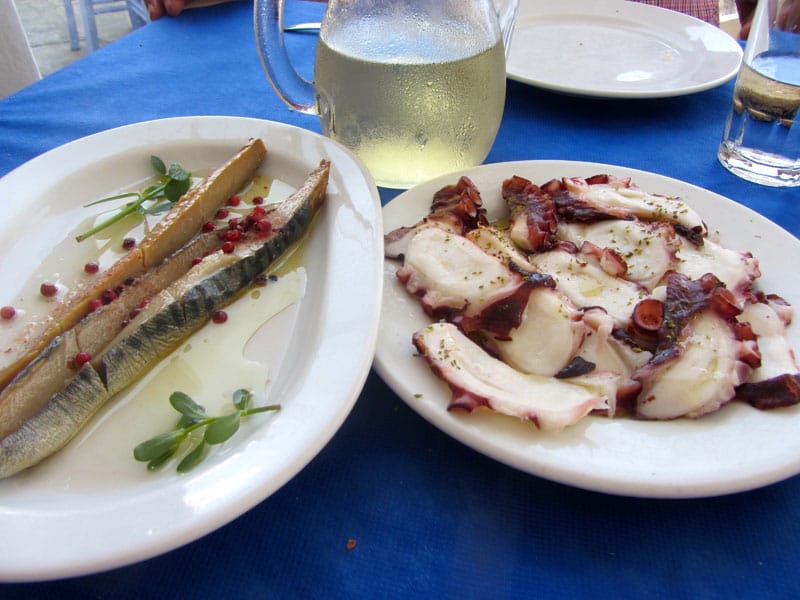
Today’s guests must content themselves with paper-thin slices of octopus carpaccio, crisp chunks of fried cod with deceptively smooth garlic sauce (skordalia), monkfish fricassee, seafood in all sorts of guises, from risottos and pastas to sautés and winey stews, colorful salads and even a couple of inspired desserts. It’s always a dilemma to limit ourselves to what we can actually eat. Although fish is the main theme, we invariably leave room for the keftedes. Foteini has a passion for them, as one of her fondest early memories is helping her grandmother knead a big bowl of the meat, bread and herb mixture.
Our final stop on this eating spree on Andros is Korthi Bay (Ormos Korthiou), about half an hour’s drive east of Hora. Strung out along a very exposed beach, Korthi is the least touristy of Andros’s four main settlements, but you might want to visit just to eat at Sea Satin Nino. Dimitris Giginis, who opened this all-day bar, café and restaurant five years ago, intends to make Korthi the gastronomic center of the island and has refused offers to relocate to Hora.
Although he never attended cooking school, Giginis is an accomplished, inventive chef and has the restaurant business in his veins. His grandfather had a well-known taverna in Piraeus that catered to the Sixth Fleet in the ’50s and ’60s, until he moved back to Andros. His new place in a village above the bay was famous for its froutalia. His father cooked on cruise ships before he took over. That place closed in the ’80s. Giginis, now 40, began his career with his own café almost 20 years ago. He had a few other eateries and traveled widely, learning about food, but it was his Korthiot wife’s idea to open a restaurant in their hometown, with her mother and brother.
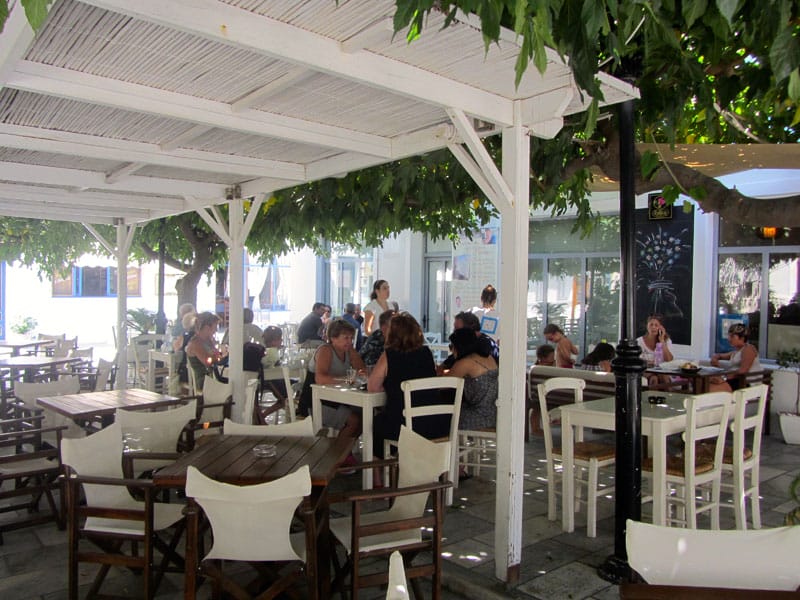
After a meal of the most original twists on classics – a “Korthianese” salad of lightly sautéed whole baby tomatoes with grilled local cheese, small calamari with pesto, fava with caramelized onions (sweet enough to have as dessert), and sardines stuffed with pink, slightly pickled shaved onions – our companion pronounced it the most interesting food on Andros. We looked longingly at the menu, wishing we could start over and sample the octopus grilled with beets, the anchovies marinated with oil, lemon and lemon balm and accompanied by fried chickpeas, the pizzas that others were relishing, or even the 750-gram T-bone steak and tempting round fries. Instead, we decided on some of the house ice cream, made with local milk, in flavors like pavlova, fig, lime and several intensities of chocolate.
Wherever you eat on Andros, we offer the following advice given by Epicurus in the 3rd century B.C. (and which is printed on the back of O Nonas’s menu): “Select with whom one will eat and drink before selecting what to eat and drink.” And we wish you kali orexi (bon appétit) in good company.
Although the food on Andros can be wonderful, unfortunately the same cannot be said about the wine. The local stuff is undrinkable unless you happen to have been brought up on it. Most restaurants have a house wine from an acceptable box, but few have a decent wine list, and when bottled wine is available, it tends to be outrageously expensive. Beer, ouzo and tsipouro are more reliable.
Published on August 25, 2015
Related stories
July 26, 2013
AthensPiraeus holds the distinction of being Greece’s biggest port, as well as the largest passenger port in Europe. Although it is a mere 20-minute train ride from downtown Athens, most Athenians think of Piraeus with a reverence reserved for a foreign country. There is just something almost mythic about this ancient port, which has been…
November 2, 2016
AthensSome of the most unique and dramatic scenery in Greece can be found in Mani, a dry, wild region in the south-central part of the Peloponnesian peninsula. Bookended by the Messinian Gulf to the west and the Laconian Gulf to the east, the area is a unique combination of stone, sun, sea and mountains. Here,…
August 22, 2016
AthensAs one approaches the port of Ermoupolis (named after Hermes, the god of commerce), the main town of the island of Syros and capital of the Cyclades, one cannot help but marvel at its beauty and grandeur. Imposing public buildings and private mansions, marble-paved streets, a large Italian-style piazza and numerous churches make the city…







































